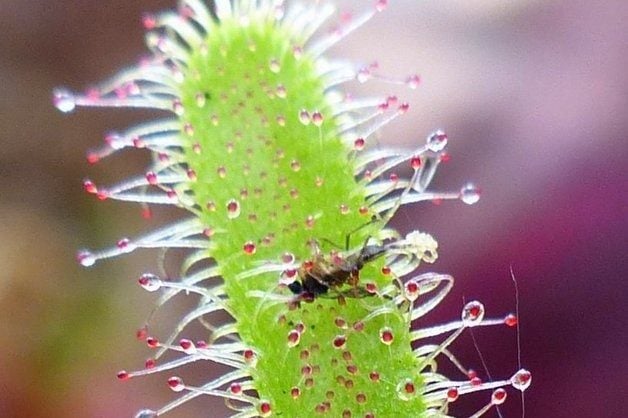So, you want to grow a carnivorous plant. "Venus Flytraps look pretty cool," you think. "Maybe I should get one." Our advice? Don't go for the Venus Flytrap just yet - they're very hard to raise. Instead, start with an easier carnivore, like Sundews (Drosera).
Sundews are found around the world (including the U.S.), but you'll probably find it easiest to start with Cape Sundews (Drosera capensis), which are native to South Africa. This species is readily available for sale and doesn't require a winter dormancy period. When buying your Drosera, make sure to purchase only from a reputable grower that doesn't collect from the wild (poaching is one of the main challenges these plants face, along with habitat destruction). California Carnivores is a respected grower, and has a wide selection. (Most of the plants for MOSI Outside's Savage Garden were purchased from California Carnivores.)
Like any plant, there are some basic needs that need to be met. These plants are not tolerant of major changes in their growing conditions, so there are a few specific rules to follow to increase your odds of having healthy plants.
Water. This is the most important - sundews (and all carnivorous plants) are very picky about their water. Whatever you do, do NOT use tap water or well water - your plants will suffer and die. Instead, use rain water (if you don't have a rain barrel, now's the time to get one!) or purified water (which can be purchased at the grocery store). Keep your drosera's potting medium moist but not wet at all times; do not let it dry out.
Light. Like all plants, sundews use sunlight to convert carbon dioxide into energy. These plants require very sunny spots; plan to give yours at least 8 hours of sunlight a day. Unless you have a south-facing window that receives strong sun all day long, you'll have to consider growing these in a container outdoors to provide the light they need (or you can use grow lights indoors, if you're really into plants).
Soil. Sundews grow in bogs, and bogs don't have regular dirt - they have sphagnum moss. And that's what your sundews will need to thrive. Fortunately, any sundew you buy should arrive potted in sphagnum moss or a sphagnum moss mixture, and since carnivorous plants don't have large root systems, the pot it arrives in will be plenty big enough for at least a year or so. If yours eventually grows large enough to need re-planting, you can find information on doing so by clicking here.
Location. We've already noted that sundews need plenty of full sunlight, and that you're best off keeping them in the pot they came in, but sundews also require a fairly humid environment to grow well. If you live in an area like the Southeast, you can simply grow them in pots outdoors - we have plenty of humidity. If you live elsewhere, you may need to provide that humid environment by growing these plants in a small terrarium. (Make sure the terrarium isn't fully enclosed, or your plant won't be able to eat the bugs it needs).
Food. At last, we get to the carnivorous part of growing these carnivorous plants. You'll notice this is last on the list; that's because it's actually the least important factor of them all. Yes, really. Carnivorous plants don't get the majority of their energy from insects; they use photosynthesis like other plants for that. What they do get from insects are the extra nutrients they need (think of it like taking a multivitamin after breakfast) to be in top condition. In general, sundews will be able to get the insects they need naturally, even if you're growing it inside (your house has more insects than you realize).
However if you really want to feed your plant, do it once a week, max. Use a pair of tweezers to place an ant or fly carefully on the plant. The tentacles will curl around it and trap it with their sticky sweet mucilage, and the digestion process will begin!
Even if you follow these guidelines, your sundews may still not thrive. These plants will do very well if you can provide the right growing conditions, but can also be very finicky. For more information on growing sundews and other carnivorous plants, we recommend the following resources:



No comments:
Post a Comment
We welcome your participation! Please note that while lively discussion and strong opinions are encouraged, the MOSI BioWorks Butterfly Garden reserves the right to delete comments that it deems inappropriate for any reason. Comments are moderated and publication times may vary.